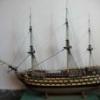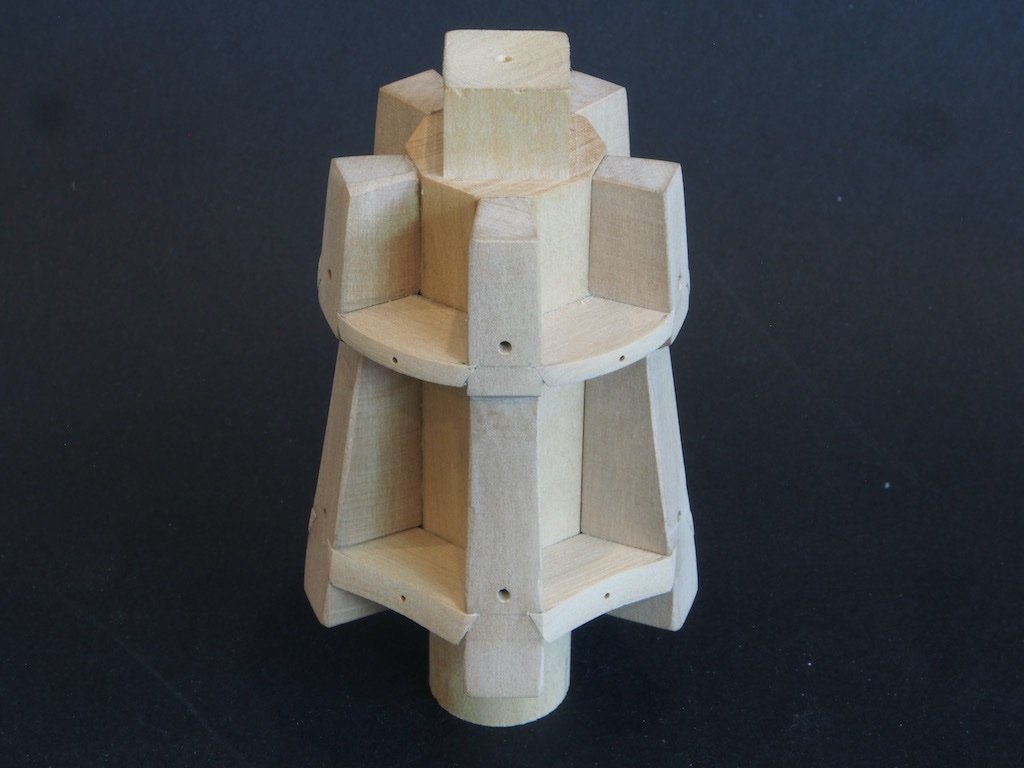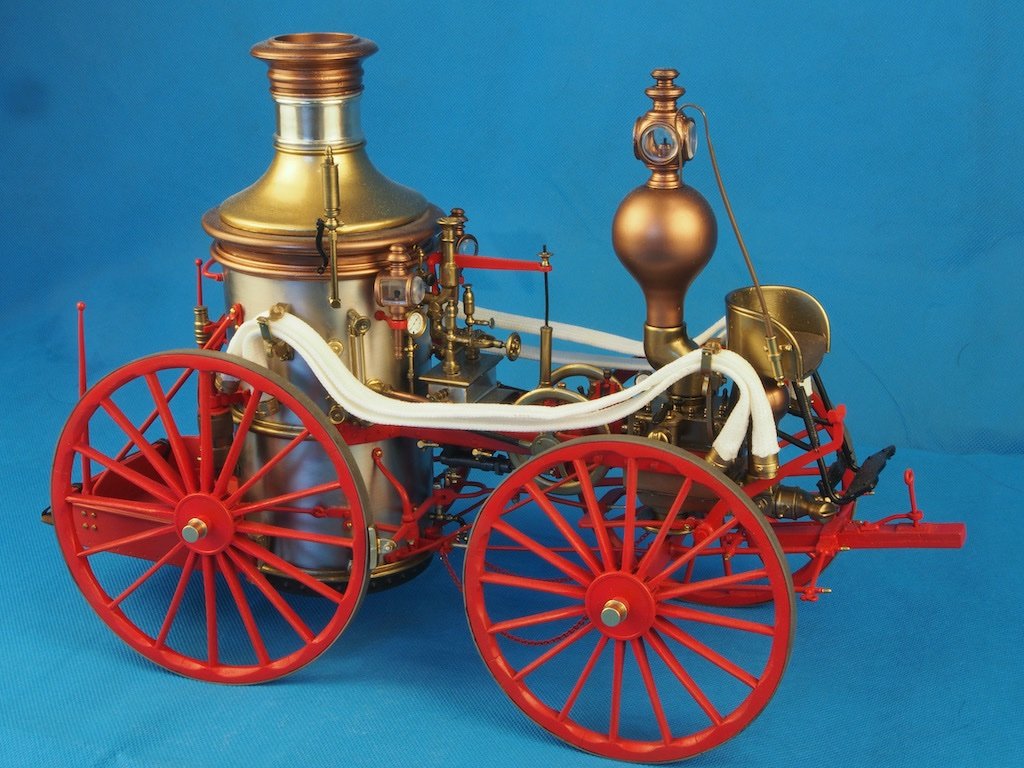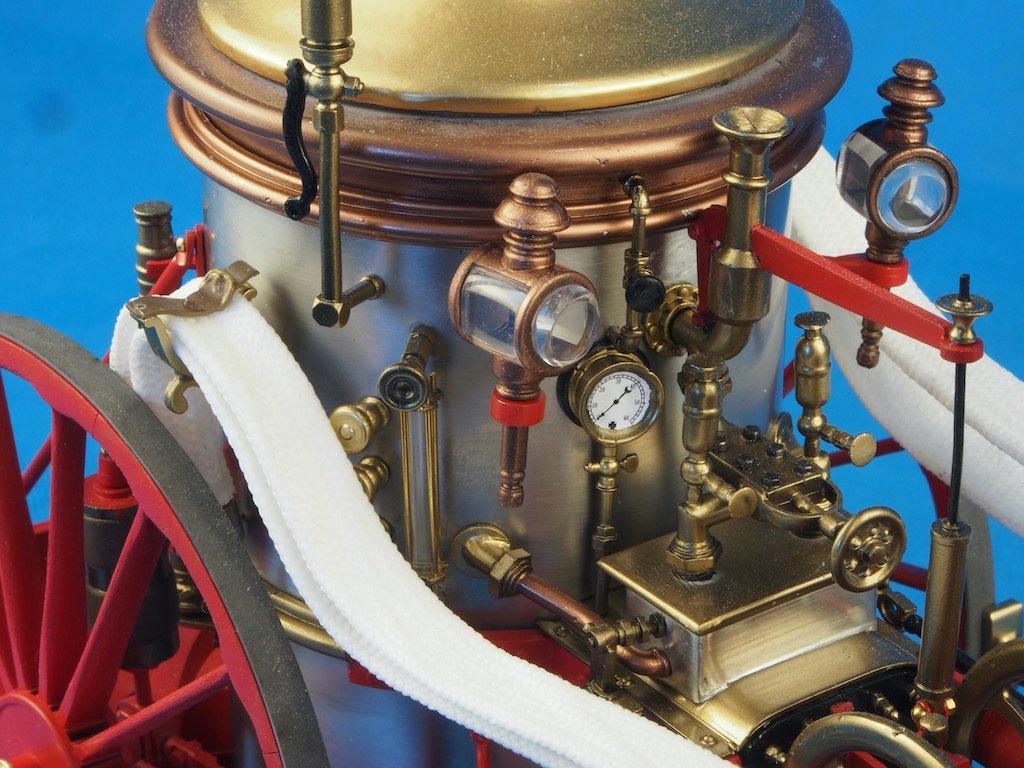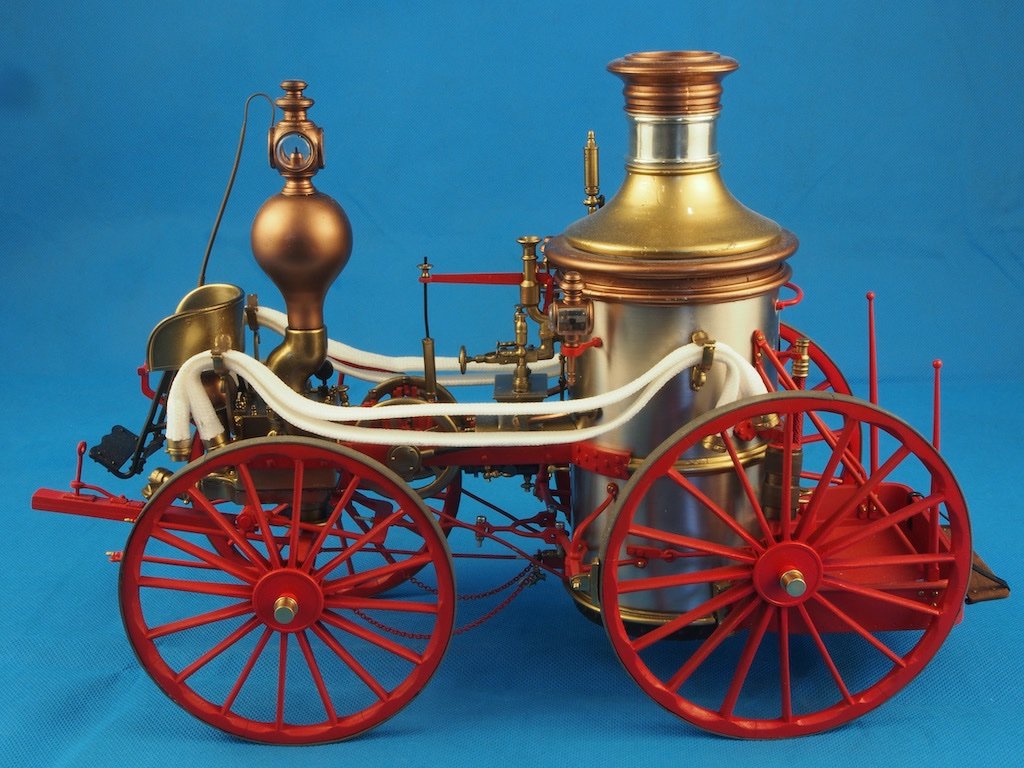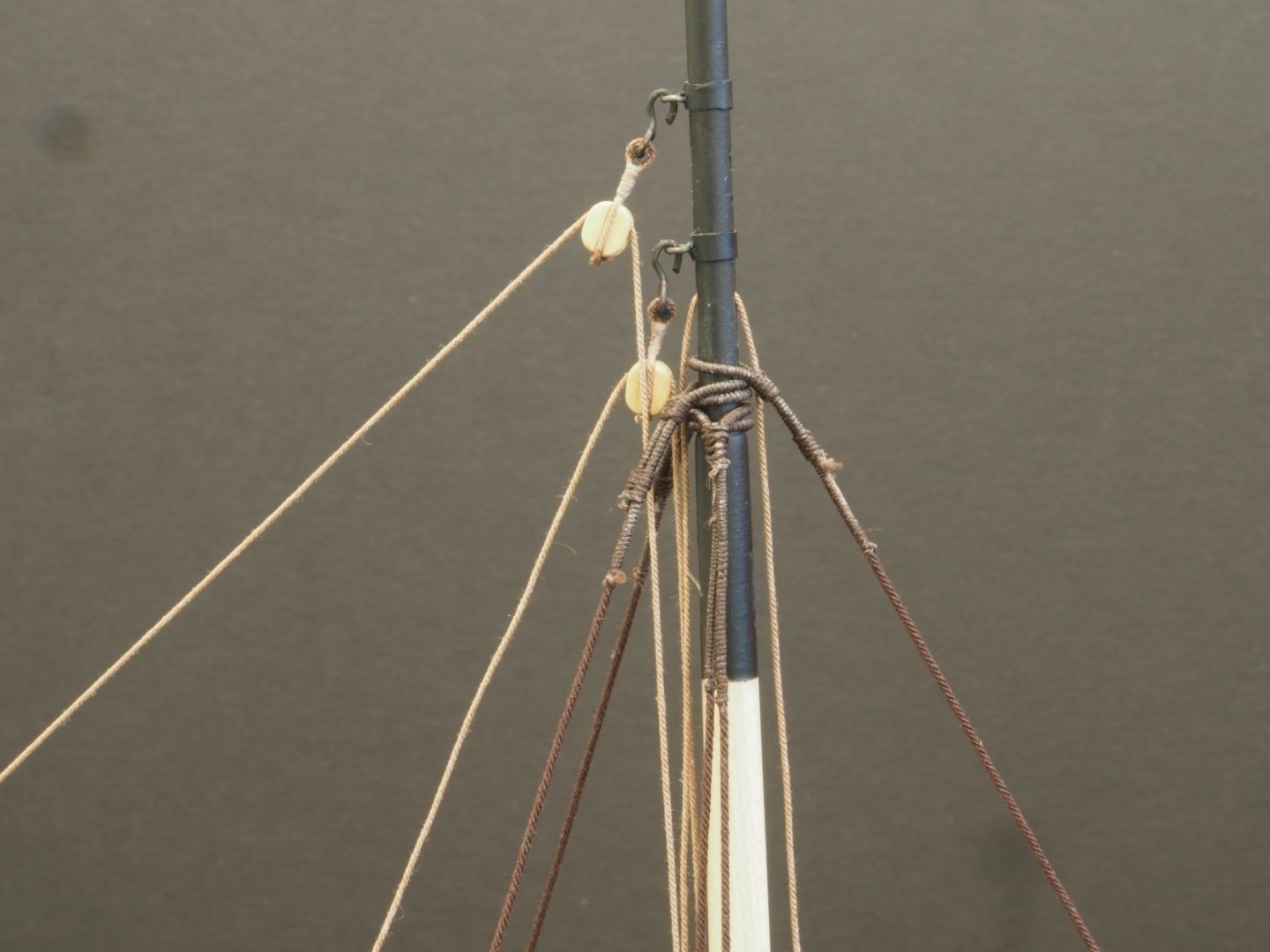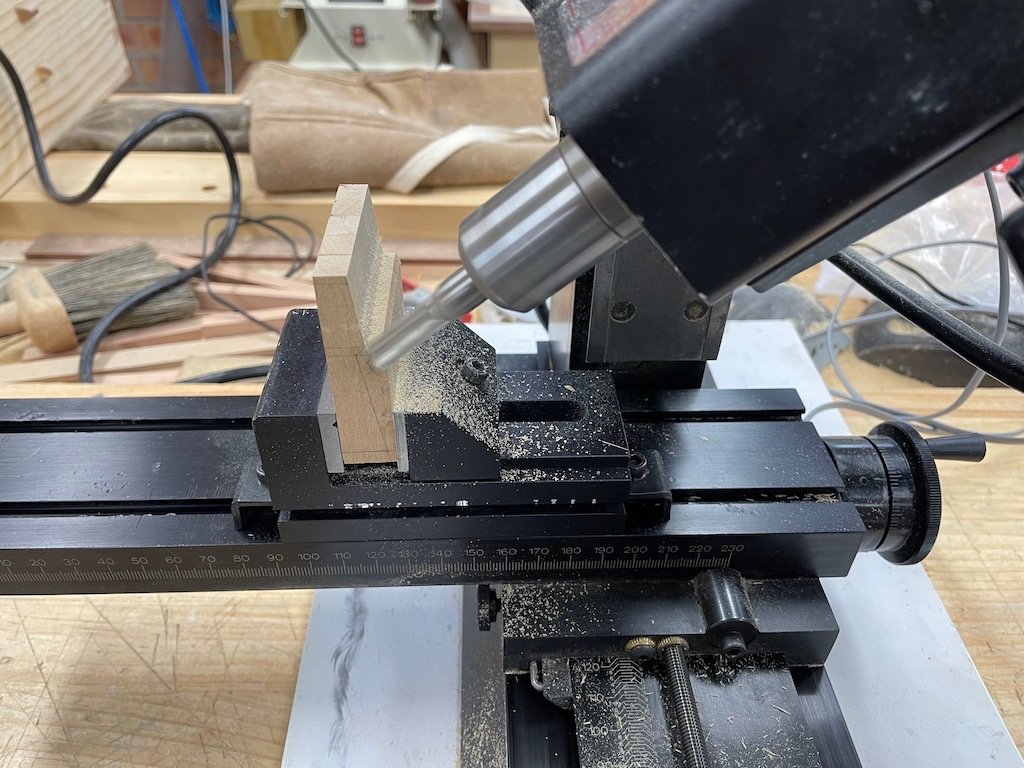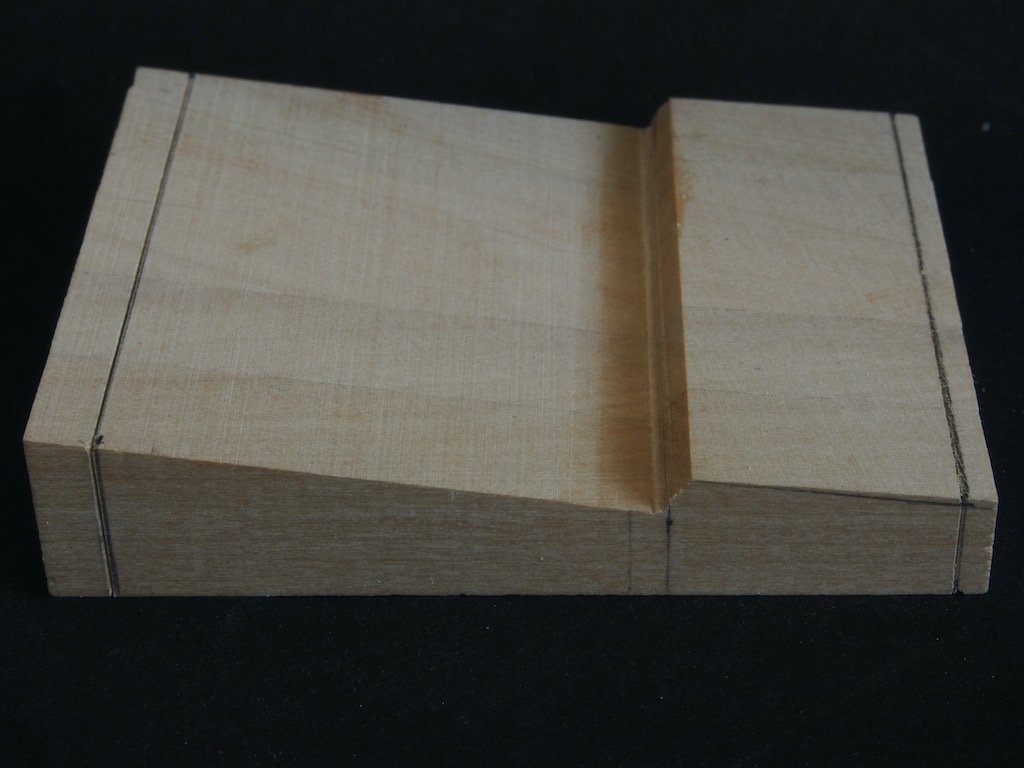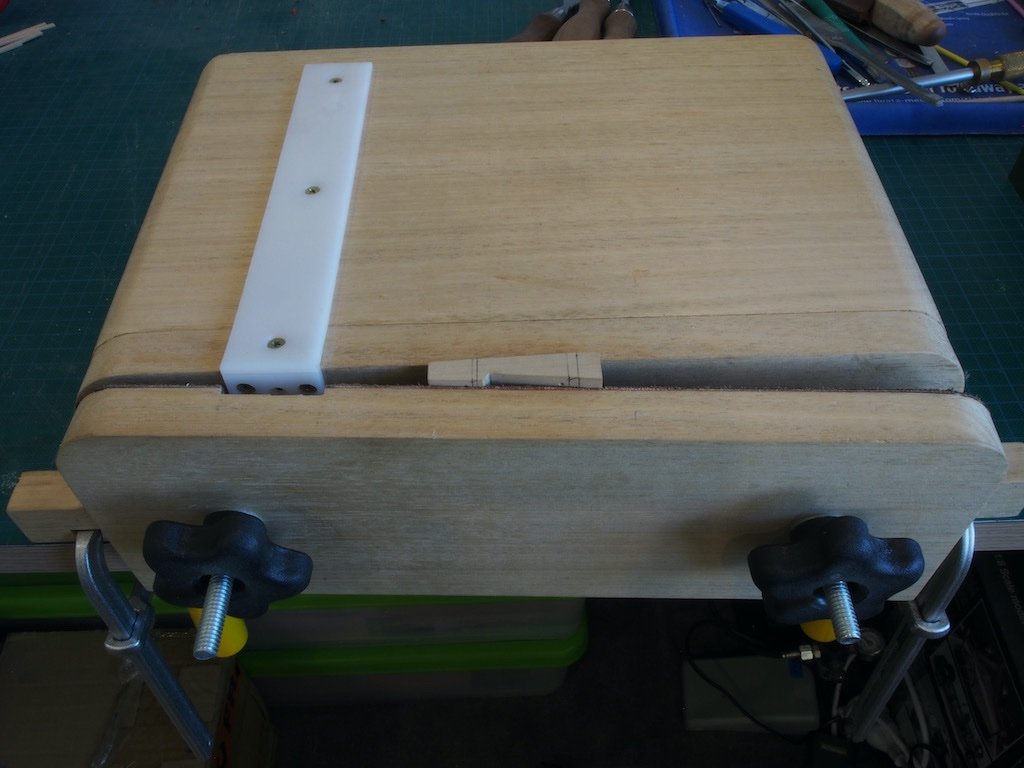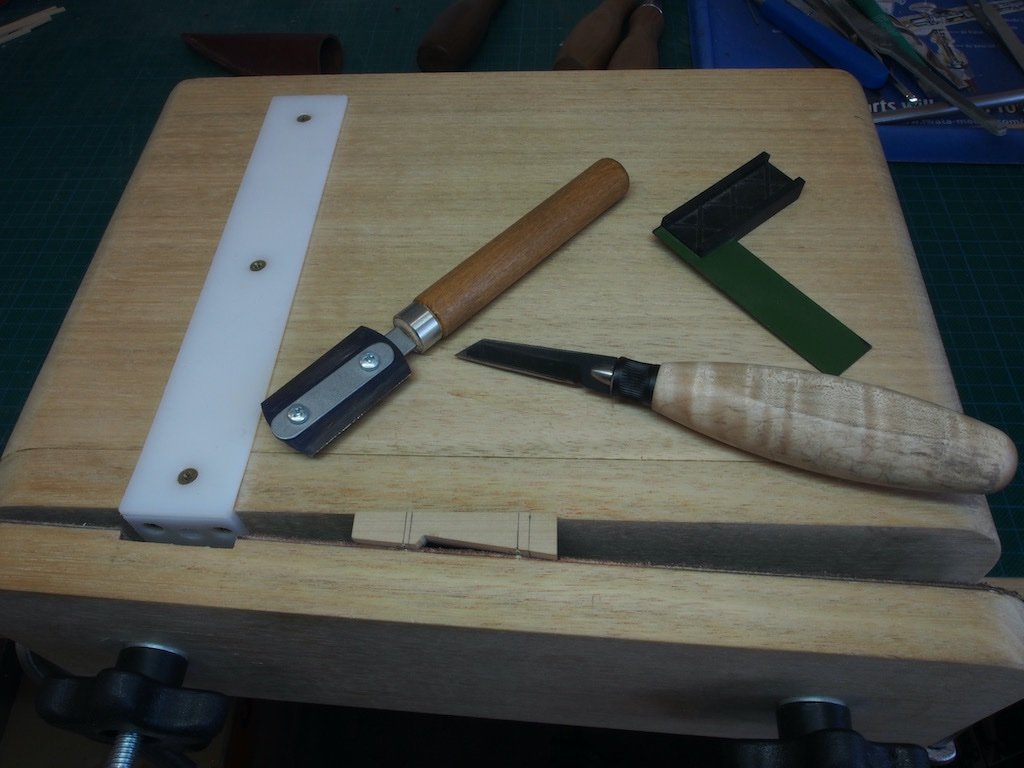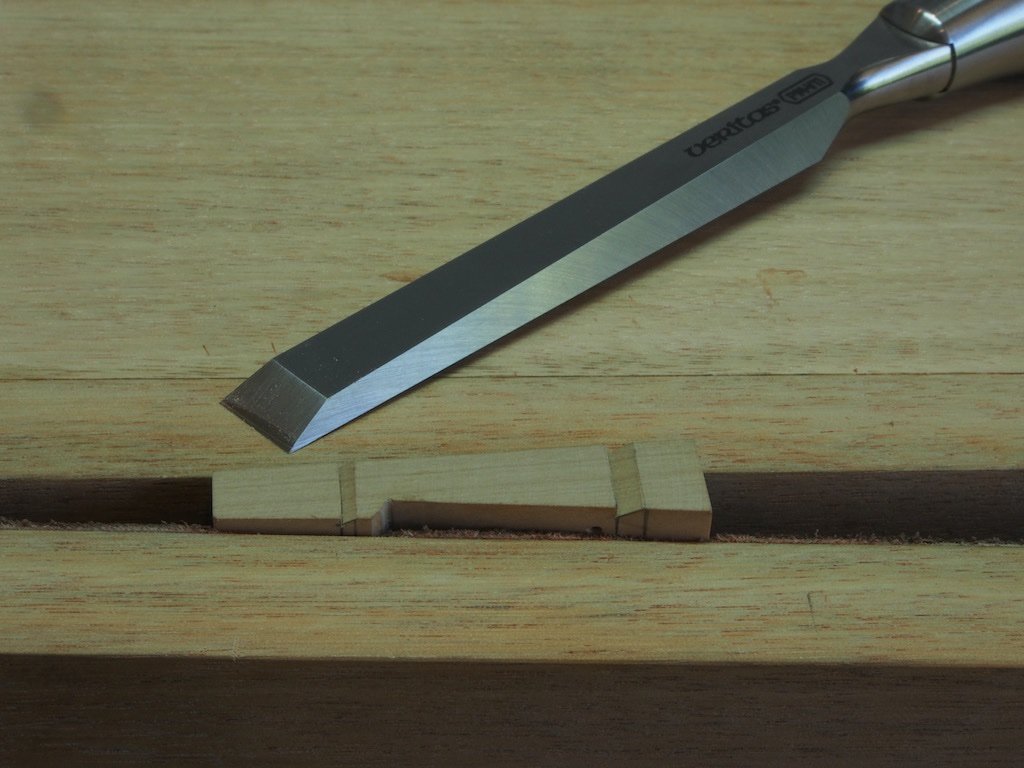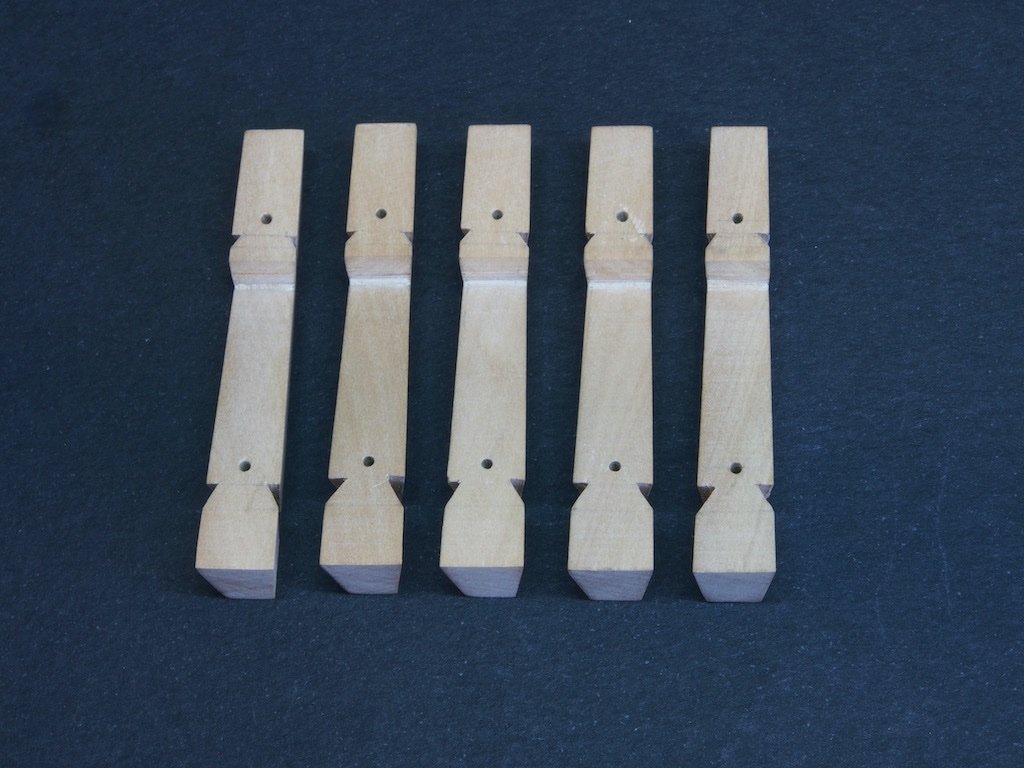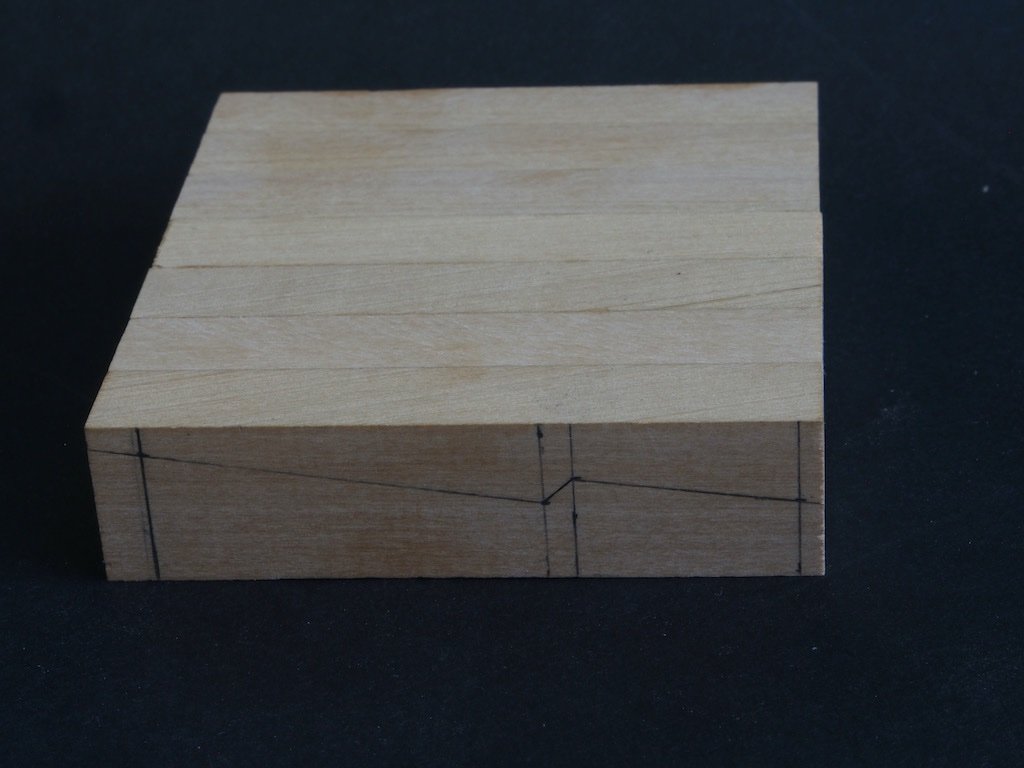-
Posts
4,888 -
Joined
-
Last visited
Content Type
Profiles
Forums
Gallery
Events
Everything posted by gjdale
-
Well done Eric! Some very neat looking joints. On your last point re matching mortices, it is better to mark both pieces at once. If you hold them together in a vice, with the ends flush, it should be a relatively easy matter to scribe across both pieces. Even if you only make a small knife mark with the tip of the knife in each, you can then complete the layout line with the pieces separated and proceed as you have described. This guarantees alignment without having to rely on your accuracy using a measuring device. My mantra is to never use a ruler/tape measure when I can use a referential measurement like this. Again, this is full-size practice in furniture making.
-
After some minor distractions over the Christmas/New Year week, the build continues. The Chocks (P/N 030 and 031) There are two sizes of chocks, with the lower one being thicker than the upper, and the angles of insertion being slightly different. They are essentially a wedge shape when viewed from above, but their sides are also tapered to match the notches cut into the whelps. To simplify construction, I drew up a plan for each in CAD using the dimensions from Toni’s drawings and then duplicated each of these to provide a strip of five templates for each of the upper and lower chocks. The templates were printed onto sticky label paper and attached to the relevant stock size. The stock was then taken to the Byrnes saw and ripped to a width that would leave plenty of extra length on the chocks for fitting, and then the individual chocks were cross-cut using the angled mitre gauge. The Byrnes disc sander was then used with the table tilted to an appropriate angle (about 30-deg) to trim the sides to a loose fit. The table was then returned to its 90-deg setting and the inner ends slowly sanded away until the chock was a tight fit. Each chock was marked with its location and the barrel also marked accordingly. The chocks were then glued in their respective locations and left overnight. Once dry, the excess material was removed firstly at the Byrnes disc sander and then with files and sandpaper to achieve the final shape. The concave face on the lower chocks was achieved by firstly making a rough shape using the oscillating spindle sander, and then refining with a contoured sanding block. Finally, the whole assembly was remounted in the 3-jaw chuck on the rotary table on the mill and the bolt holes were drilled in the chocks. I opted to drill these at 0.7mm diameter to accept some 40lb monofilament for the bolts. This is somewhat thinner than specified but looks about right to my eye. I got so focused on the process, that I forgot to take any progress pictures. Here is the completed Capstan Body. Next up, the part I’ve been dreading – the Drum Head Assembly….
-
Further to Kurt’s excellent advice, it looks to me from the photos that you used the digital calliper and a pencil to mark both edges of the mortice, which will inevitably lead to a loose fit. Use calliper and pencil to mark the rough position of one edge, then use a knife to mark the actual cut line (notice how much thinner the knife line is compared to a pencil line). Then use the carling itself, held in place against the knife line with a small square and mark the second edge, again with a knife. If you use the knife to get really tight against the carling, or perhaps even just under the edge of it, you will end up with a tight joint. The knife lines will provide you with a good reference line to make your saw cuts with a razor saw prior to chiselling out the waste. As Kurt has said, this is how furniture makers do it.
-
Thank you very much Mark, Kevin, Bob, Gary and Patrick for your kind words, and to all of the “likes” as well. The model has grown further on the Admiral, who has now requested (nay, ordered) that it take up permanent residency in its “temporary” home in the dining room. Although it has felt at times that the model fought me every step of the way, to have this reaction to the end result instead of just “tolerance” makes it that much more worthwhile. 😊 I’ll be having a case made for it in a week or so when businesses start back up after the Xmas break.
-
Hey guys, Can anyone (other than Richard, who has spent enough time on this already!) answer this for me please? When I play the file within Dropbox, it is the edited version that runs for approximately one hour, however if I download the file, it downloads as the unedited 4 hr 40 min version. Any clues as to why this is so and/or how to download the shorter, edited version? (I'm using a Mac, in case that makes a difference). BTW, thanks to those who suggested using VLC - that fixed the sound issue I was having.
-
Hi Richard, Thanks so much for doing this. I just followed your link and it appears that you've put an edited version up in Dropbox that runs for about one hour. However, when I downloaded it from drop box, it seems to download the full 4hr 40min version. Any idea why this is so? (I'm not all that familiar with using Dropbox, so it could well be "operator error"). Also just discovered that with the long version that downloads, there is no sound at all.......
-
Final Completion After a frustrating couple of months waiting for parts, the model is finally completed. I managed to source locally (relatively) some clear plastic rod of the correct diameter to complete the boiler gauge sight glass. I also took some time to write a constructive email to Model Expo with a detailed list of the errors in parts, and in the instructions, that I had encountered and asked only for replacements for the hoses and three bolts. I figured that since Model Expo claim a free parts replacement service this shouldn’t be too hard, especially since I had gone to the trouble of clearly identifying the issues for them. Turned out not to be quite that simple. It was only after I involved the company owner (Marc Mosko) that I even got a response to my emails – the first email went completely unanswered for a month before I wrote a second time. Then a person in the parts department took it upon themselves to make it more difficult than it needed to be by insisting that I complete their online form for replacement parts, even though I had already provided every single piece of information on that form and more. That same person also told me that I would receive exactly the same parts as originally provided (never mind that the parts were incorrect). I was not prepared to put up with this nonsense so once again drew Marc Mosko into the conversation. Someone must have received the proverbial kick in the pants because I was then contacted by someone else in the parts department who couldn’t have been more helpful. The only further snag was that because of the cost of postage these days, they decided to include my replacement parts in a shipment to their Australian distributor, who would then forward my parts on to me. I can’t fault them for that – in fact it was a sensible approach. Anyway, the parts finally arrived on 29 Dec (more than two months since my first email) so Model Expo did make good on their promise and I’m grateful for that, even if their customer service is somewhat lacking. Once I had the hose material in hand, it was a simple matter to cut them to approximate length, dip the ends in CA glue to stop them fraying and while the glue was still wet, insert the end of a paintbrush to open the ends and stop them sticking together. Once the CA had dried, the hose ends were trimmed to final length and the hose connectors inserted and glued in place. The hoses were then painted with a liberal amount of watered down PVA glue (50/50 glue/water mix) and left overnight to dry. This made the hoses relatively stiff but still malleable and able to be formed to some sort of shape prior to installing on the model. So here at last are some final shots of the completed model. The Stbd side: A close-up of the Boiler Water Level Sight Gauge: And the Port side: Despite its many frustrations, this has been an enjoyable build and I’m well pleased with the final product. More importantly, the Admiral likes it, and it is now on display in a temporary home in the dining room. Now I can get back to finishing my Capstan project.
-
That must have been frustrating for you Bug, but you’ve made a very nice recovery.👍
- 419 replies
-
- Victory Models
- Pegasus
-
(and 2 more)
Tagged with:
-
At the risk of “teaching grandma to suck eggs”, to get accurate joints, mark your cutting lines with a knife rather than a pencil and use referential measurement whenever you can (eg mark the first cut line for a mortice from the given measurement from the end of the piece, then mark the second cut line by placing your tenon piece against the first cut line and using it to define the width for the second cut line). Hope that makes sense.
-
Hey Eric, A couple of things I found in using my spreadsheet: In addition to having a table of the stock dimensions, I have found it useful to create an extra box to enter specific or one-off measurements and have the computer spit back out the appropriate scale dimensions in fractional inches, thousandths, and metric. I could then write these onto Toni's drawings as needed. Like you, I am "bi-lingual" when it comes to imperial/metric measurements. Although I use metric for the lathe and mill because that is how they are geared/calibrated, I have found it much easier to stick with imperial units for everything else as the conversion to scale size seems to be generally a little "cleaner" to use (eg an inch ruler might have 32nds marked on it, but a metric one doesn't have x.3mm etc). The digital caliper with both fractional and decimal inches (as well as mm) is your friend! For accurate mortises, a knife line and a very sharp chisel are the key to success (as I'm sure you know from your other woodworking).
-
Well done on your victory over the PE Mark, she’s looking great!
- 505 replies
-
- vanguard models
- Sphinx
-
(and 1 more)
Tagged with:
-
Dave, A little research on your subject ship should tell you the actual sizes of the various blocks and ropes used. The Anatomy of a Ship series is often a good start. There are various other sources that can provide guidance on typical rigging sizes used for your size of ship for its particular time period. Once you have that information, just create a spreadsheet to convert the actual size to your chosen scale in the measurement units of your choice.
-
Thanks Glen, Apart from three requisitioned by the Admiral, all of the other reindeer were given away to family and friends, where they all received warm welcomes into their new homes.
-
Thanks for the kind comments Ben and Rusty, and for all of the likes. Life seems to have gotten in the way lately, so progress has been slow. The Whelps (P/N 029) Five Whelps are required and the particular challenge in making these is that they are tapered both top to bottom and rear to front. The first step was to cut some blanks and then glue them up into a sandwich with the basic profile outline on one face. Toni’s advice in the instructions was to make a couple of spares, so initially I glued up a set of seven blanks. Unfortunately, when it came to milling the sandwich, I found that it was too wide for the mill travel, so I had to unglue them and re-glue with just five in the sandwich. The basic profile was then cut on the mill by angling the milling head as shown by Toni in the instructions. Here is my set-up halfway through the milling process: And here is the end result. Note that the blanks were left slightly long to allow for any chip-out during milling. The blank was then taken to the Byrnes saw and trimmed to length prior to soaking in an IPA bath to separate the individual pieces. Once separated, holes were drilled for the bolts and the individual pieces carefully marked out for the tapers. The top to bottom taper was tackled first, and is relatively simple to achieve using the Byrnes disc sander to freehand sand to the marked lines. The rear to front taper was a little trickier. After carefully marking out, the angle was measured using a protractor and the tilting table of the Byrnes sander set to this angle. With a little care, the correct taper was achieved. Here are the pieces after all tapers had been cut/sanded. The next challenge was to cut the notches for the Chocks. Like many things in woodworking (or metal working for that matter), the hardest part of the process is working out how to hold the work securely for the operation at hand. Having carefully marked out each piece for the notches, I found that my home-made Moxxon style vise was able to cope with the tapers quite well to hold the work. I then used a miniature square and a marking knife to score the vertical cut line. This then provided a handy registration for the razor saw to make the vertical cut. A freshly sharpened full sized chisel was then used to pare the angled cuts. Having worked out how to hold the pieces, the actual cutting of the notches went quite quickly. Here are the completed Whelps. The Chocks will be next but will probably have to wait a day or two until after the fat man in the red suit has been.
-
Congratulations on completing a fine build Andrew. You can be justifiably proud of your results.
- 161 replies
-
- Model Shipways
- Emma C Berry
-
(and 1 more)
Tagged with:
-
Nice trick with the wedge Andrew - thanks for sharing.
- 161 replies
-
- Model Shipways
- Emma C Berry
-
(and 1 more)
Tagged with:
About us
Modelshipworld - Advancing Ship Modeling through Research
SSL Secured
Your security is important for us so this Website is SSL-Secured
NRG Mailing Address
Nautical Research Guild
237 South Lincoln Street
Westmont IL, 60559-1917
Model Ship World ® and the MSW logo are Registered Trademarks, and belong to the Nautical Research Guild (United States Patent and Trademark Office: No. 6,929,264 & No. 6,929,274, registered Dec. 20, 2022)
Helpful Links
About the NRG
If you enjoy building ship models that are historically accurate as well as beautiful, then The Nautical Research Guild (NRG) is just right for you.
The Guild is a non-profit educational organization whose mission is to “Advance Ship Modeling Through Research”. We provide support to our members in their efforts to raise the quality of their model ships.
The Nautical Research Guild has published our world-renowned quarterly magazine, The Nautical Research Journal, since 1955. The pages of the Journal are full of articles by accomplished ship modelers who show you how they create those exquisite details on their models, and by maritime historians who show you the correct details to build. The Journal is available in both print and digital editions. Go to the NRG web site (www.thenrg.org) to download a complimentary digital copy of the Journal. The NRG also publishes plan sets, books and compilations of back issues of the Journal and the former Ships in Scale and Model Ship Builder magazines.


